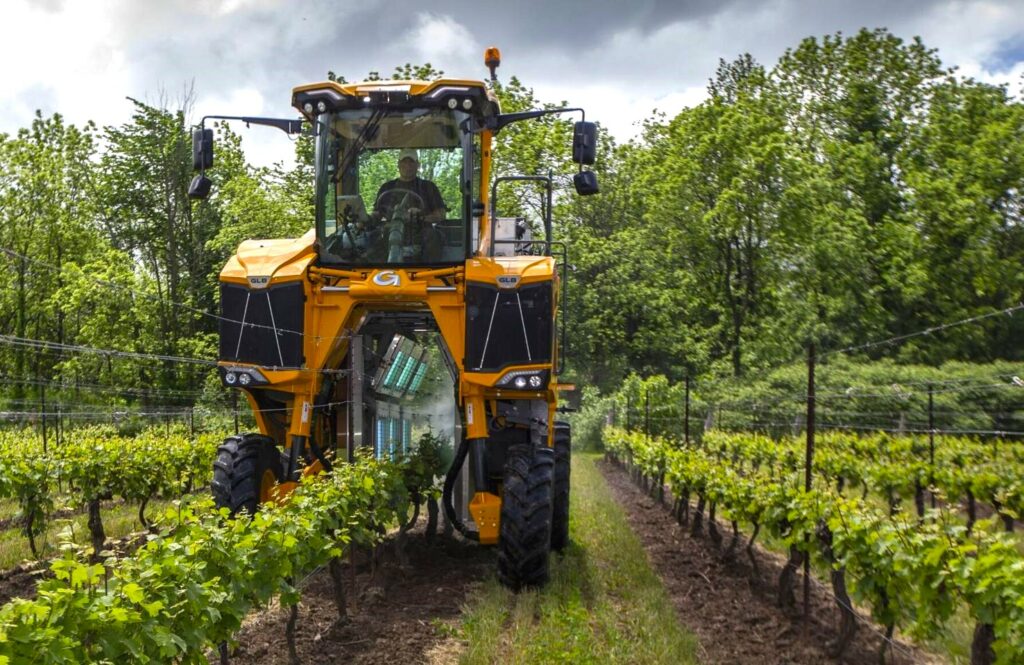Source: The Standard
Bolted onto the back of a traditional grape harvester is a stainless-steel contraption with ultraviolet light mechanisms.
Vineland Estates Winery winemaker Brian Schmidt drives the machine through the fields, treating rows of vines with Clean Works technology — a combination of ozone, ultraviolet light and a small amount of hydrogen peroxide mist.
Ultraviolet light has antiseptic properties, but in this case, it’s being used as an energy source that breaks up ozone and hydrogen peroxide, forming hydroxyl radical.
As the machine rolls across, the unstable and reactive OH attaches itself, oxidizes and kills any organic pathogens in the grapevines.
It took months of adjustments, prototypes and field testing, but the technology has shown to provide more than 99 per cent protection against powdery mildew and other pathogens known to be harmful to grapevines.
Without the use of chemical pesticides.
The technological innovation by Clean Works has implications that could benefit grape growers and wine producers around the world.
“To say that I’m excited about it is a profound understatement,” said Schmidt.
Clean Works — founded as a joint venture of Moyer’s Apple Products Inc. in Jordan Station and Court Holdings Ltd. of Beamsville — was initially focused on post-harvest, cleaning food without water and extending product shelf life.
About three years ago, the company teamed up with Vineland Estates to see if it could use its Clean Verification technology to address pre-harvest concerns — while products were still in the ground.
Seeing an opportunity to increase grape crop yield and decrease chemicals, Clean Works applied to the federal government’s Food Waste Reduction Challenge. Earlier this month, the St. Catharines-based company was named the grand prize winner, earning a $1-million grant.
“It was incredible, it just really solidified that we are on the right track,” said Denise VanderVeen, director of business development for Clean Works.
“It’s that confidence to bring it to market, that we had a panel of highest experts, the highest level of government, look at this and say you’re onto something and you can really change the ideas around sustainability and food waste.”
Working alongside Vineland Estates and having its co-operation to do vineyard testing was the support and expertise the company needed to “really validate and see what this technology can do.”
“We really got to see how it could control mould and mildew directly in a field, which is incredible for us to actually see the impact we can have on our commercial partners, on our farmers, on the vineyards,” she said.
For Schmidt, who is also vice-president of Vineland Estates, it has been “fascinating” to work with the technology, particularly from a sustainability perspective. The winery was one of the first in Niagara to be named sustainable and is always looking at ways to minimize its environmental footprint.
The new technology not only reduced chemical usage but also significantly reduced water usage, fuel costs and soil compaction.
“Normally, sprayers would (need) several thousand litres of water to be towed behind a tractor and sprayed into the vineyard. The water use is considerably less whereas we’ve only using several hundred litres of water per day,” said Schmidt.
“For places like California, ultimately, that’s going to be incredibly important.”
Just as important are the benefits for grape production.
Last summer was particularly challenging for Niagara vineyards, with an excessive amount of rainfall from mid-June to September.
“Having the pressure that we had and the system being able to respond positively to that and mitigate risks for us in terms of pathogens and the problems in the vineyard was absolutely amazing,” he said.
Vineland Estates president Allan Schmidt said local vineyards are struggling with powdery mildew and chemical fungicides, as plants build resistance to treatment.
Niagara grows about 75,000 tonnes of grapes each year, but it’s not uncommon for about 5,000 tonnes to be infected and unable to be harvested.
“That 5,000 tonnes represents about five million bottles of wine that don’t get made, but all the costs for growing them,” he said.
What vineyards need is an alternative option, which is what Clean Works offers. Because the process kills the pathogens at a cellular level, there is no resistance.
When the Bordeaux mixture was introduced more than 100 years ago, it was a game-changer, ensuring grape growing on vines could have a greater chance of success, but it’s a chemical, he said. This technology is all natural, the “largest advancement in natural and sustainable crop and food protection and safety since the discovery of pasteurization 150 years ago.”
For Vineland Estates, this will be the first complete season using the technology. The vineyard performed the first application about two weeks ago, and will apply it on a regulated basis, with scientists from Vineland Research and Innovation Centre coming to track all the information.
VanderVeen said Clean Works wants one more year under its belt before going to market — to validate the work and make tweaks to ensure it’s user-friendly — but the response from vineyards has been “incredibly encouraging.”
“When you say you’ve got something for powdery mildew, everybody’s ears perk up because it’s a battle for all vineyards,” she said.
“We’ve already been getting questions of how do we get it out to the West Coast, how do we get it out to California. It was very obvious that there is a huge gap that needs to be filled. On the commercial side, they’re ready for a more sustainable tool to bring to their vineyards.”

